While the benefits of AI in SaaS and the benefits of ML in SaaS are undeniable, automation, personalization, cost savings, and smarter decision-making; scaling AI/ML within SaaS products presents a wide range of challenges.
For SaaS companies eager to ride this wave, scaling AI SaaS or scaling ML SaaS requires much more than adding a few AI models to existing platforms. Without the right strategy, companies risk falling into costly pitfalls of scaling AI SaaS, from infrastructure bottlenecks to customer churn, ethical missteps, and rising operational costs.
In this blog, we’ll explore the 10 most common pitfalls of scaling AI/ML SaaS, share strategies to overcome them, highlight industry best practices for successful SaaS design, and provide insights into building resilient, future-ready SaaS platforms.
Why Scaling AI/ML SaaS Matters
Before jumping into the pitfalls of scaling ML SaaS, it’s essential to understand why scaling AI/ML SaaS is fundamentally different from scaling traditional SaaS. While traditional software scales linearly with the number of users or transactions, AI/ML applications scale exponentially, driven by complex interdependencies and unique demands.
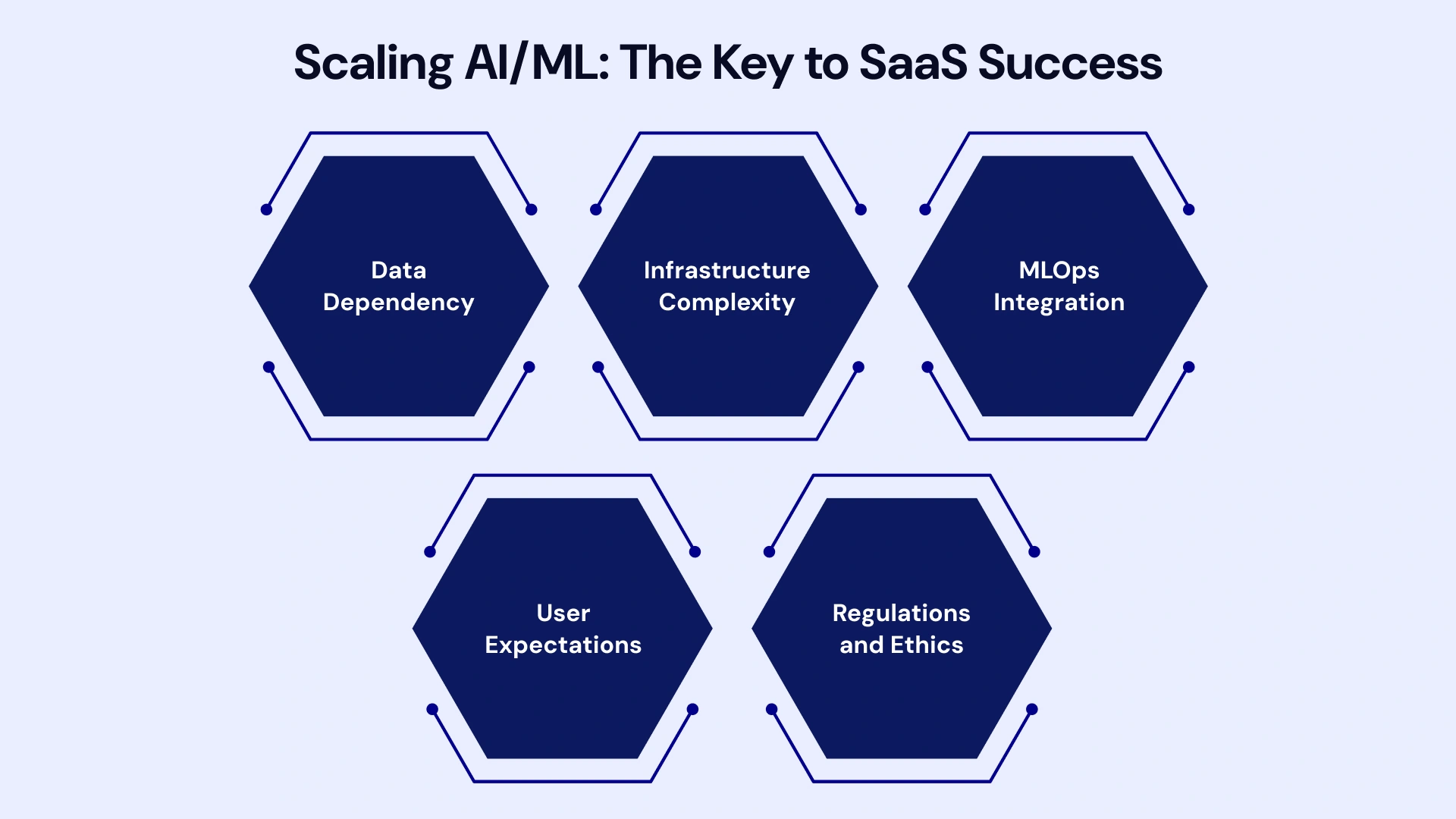
Data Dependency:
Unlike generic SaaS applications that are often stateless, AI/ML applications are inherently data-driven. They don’t just process data; they learn from it. This means that scaling insufficient data only amplifies errors and leads to inaccurate results. The entire system's performance is directly tied to the quality, volume, and velocity of the data it consumes. This is a primary AI/ML SaaS scaling challenge that requires robust data governance for AI/ML SaaS strategy from the outset.
Infrastructure Complexity:
AI/ML models require a level of computational power far beyond what traditional SaaS applications demand. Training large-scale models requires intensive, specialized hardware, such as GPUs or TPUs, while real-time inference in production necessitates low-latency, high-throughput systems. This dual requirement for powerful compute and efficient delivery creates unique infrastructure challenges for AI SaaS. Companies must strategically build scalable infrastructure that is both cost-effective for training and highly performant for serving models to millions of users.
MLOps Integration:
The lifecycle of an AI/ML model is not a one-and-done process. A model’s effectiveness degrades over time as real-world data changes; a phenomenon known as model drift. This makes continuous monitoring, re-training, and deployment a non-negotiable part of the process. The MLOps maturity in ML SaaS is a critical differentiator. Companies with a mature MLOps practice can automatically detect issues, such as model drift, in production ML SaaS and deploy a new, updated model without human intervention, ensuring the product remains valuable.
User Expectations:
The benefits of AI in SaaS and the benefits of ML in SaaS have raised the bar for user expectations. Clients don't just expect the software to perform a function; they expect it to be intelligent, predictive, and personalized. They demand real-time insights and accurate predictions. Meeting these expectations at scale requires a seamless and responsive user experience, which is only possible with a well-architected AI/ML backend.
Regulations and Ethics:
As AI SaaS platforms handle vast amounts of sensitive data, they are subject to increasing scrutiny and regulation. Laws such as GDPR, CCPA, and upcoming AI-specific regulations make data governance for AI/ML SaaS more challenging. Companies must not only ensure the quality of their data but also its privacy, security, and ethical use. Failing to address ethical concerns can lead to significant legal and reputational damage.
Successfully scaling AI SaaS not only improves user experiences but also maximizes ROI and creates a sustainable competitive market advantage. It's about moving from a proof-of-concept to a reliable, revenue-generating engine that can grow with your business.
10 Common Pitfalls in Scaling AI/ML SaaS
Building an AI/ML SaaS product is complex, but scaling it successfully introduces a whole new set of challenges. As your user base and data grow, what worked initially can quickly become a bottleneck.
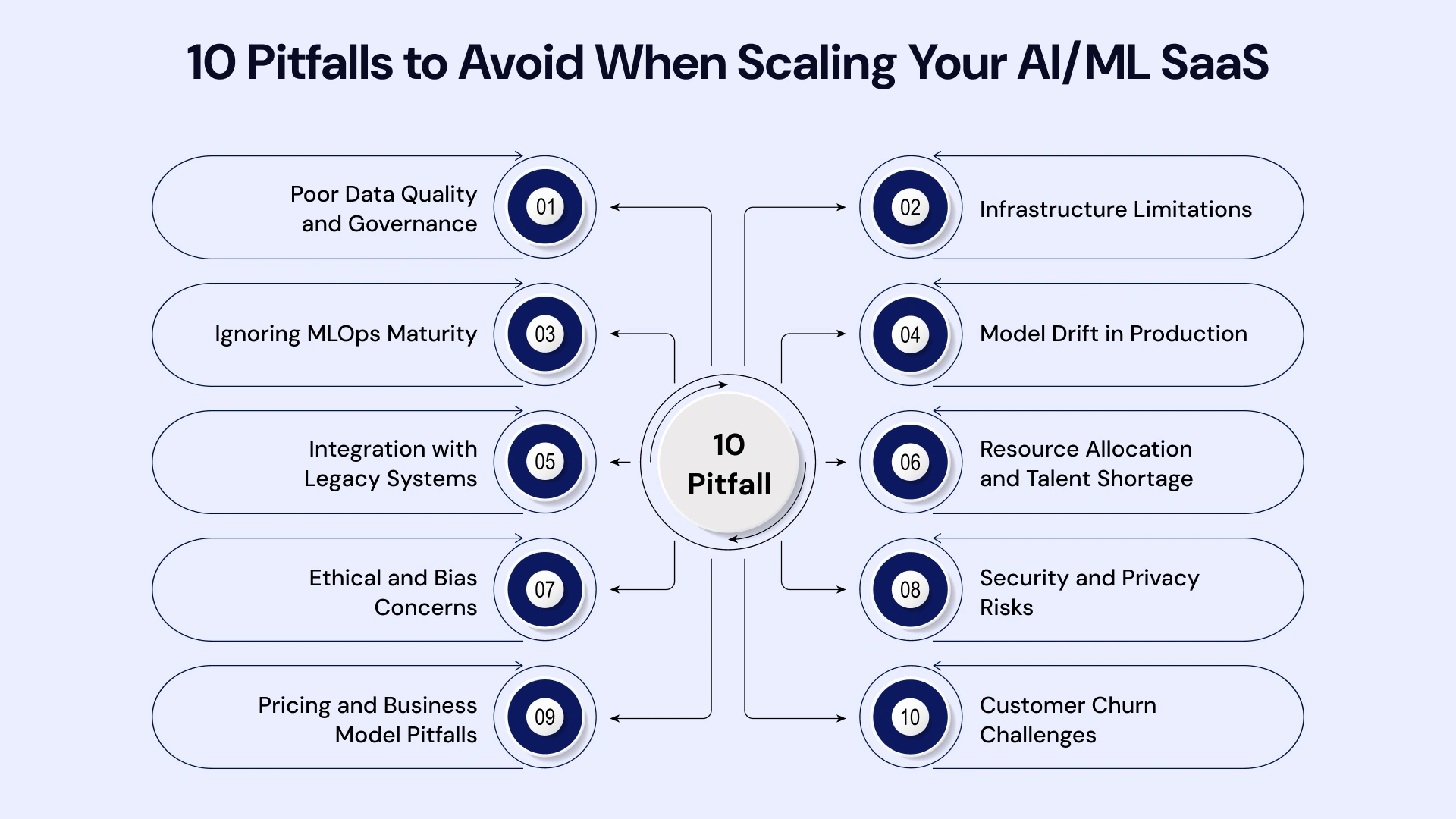
Here are 10 common pitfalls to avoid when scaling your AI/ML SaaS:
1. Poor Data Quality and Governance
One of the most overlooked AI/ML SaaS scaling challenges is starting with bad or unstructured data. According to Gartner, about 85% of AI projects fail due to data issues. Poor labeling, inconsistent pipelines, and a lack of clear ownership often lead to model inaccuracies, making the entire system unreliable.
- Pitfall: Neglecting data governance for AI/ML SaaS. Without a clear framework for data collection, storage, and usage, a company cannot ensure the quality or compliance of its data. This leads to the classic "garbage in, garbage out" problem, where a robust model is rendered useless by flawed data.
- Solution: Invest in data quality from day one. Implement robust governance frameworks that include automated data validation and data lineage tracking. Ensure compliance with privacy laws like GDPR and CCPA, which is crucial for building trust with users.
2. Infrastructure Limitations
As a SaaS product grows, so does the demand on its underlying infrastructure. For AI/ML, this is amplified. Models demand intensive GPU/TPU resources for training and high-performance, low-latency infrastructure for inference in production. Without scalable infrastructure, latency increases and costs spiral.
- Pitfall: Inadequate scalable cloud infrastructure. Many companies initially use off-the-shelf solutions that are not designed for the unique computational needs of AI. This leads to bottlenecks, slow response times, and a poor user experience.
- Solution: Build Scalable Infrastructure on cloud-native architectures (AWS, Azure, GCP). Consider using Kubernetes-based orchestration for elasticity, which enables you to scale resources up or down automatically in response to demand. This is a critical part of a robust saas development services strategy.
3. Ignoring MLOps Maturity
An ML project may succeed in research but fail in production due to a lack of MLOps maturity in ML SaaS. Without a proper MLOps pipeline, issues such as continuous model deployment, monitoring, and a lack of feedback loops can hinder growth and lead to model decay.
- Pitfall: Treating ML model deployment as a one-time event, rather than a continuous cycle. Without automated tools for monitoring and retraining, a model's performance will inevitably degrade over time as new data patterns emerge.
- Solution: Adopt MLOps principles and invest in platforms that support Continuous Integration/Continuous Deployment (CI/CD) for ML pipelines. Automate monitoring for model drift in production ML SaaS and plan for maintenance by defining clear triggers for re-training.
4. Model Drift in Production
One of the most insidious pitfalls of scaling AI SaaS is model drift in production ML SaaS. This occurs when the underlying data distribution changes, causing the model's accuracy and prediction quality to degrade over time without any code changes.
- Pitfall: Not detecting or retraining fast enough. If a company doesn't have a system in place to monitor for data and concept drift, its AI will slowly become less effective, leading to a loss of customer trust and value.
- Solution: Implement continuous monitoring to track key performance indicators (KPIs) of your models in real-time. Set up automated retraining pipelines and alerts that trigger when performance drops below a certain threshold.
5. Integration with Legacy Systems
Enterprise clients often expect SaaS providers to seamlessly integrate AI features into their existing legacy systems, such as ERP, CRM, and HR platforms. However, technical debt and outdated architectures in these legacy systems can create significant bottlenecks.
- Pitfall: Poor handling of integrating with legacy systems in AI SaaS. Trying to force-fit a modern, microservices-based AI solution into a rigid, monolithic legacy system can lead to technical complexity, data silos, and a poor user experience.
- Solution: Utilize middleware, APIs, and microservices to serve as a bridge between the new AI components and existing systems. This approach allows for a more flexible and modular architecture. Choose the right SaaS Product Development Company that has experience with hybrid architectures.
6. Resource Allocation and Talent Shortage
Scaling AI/ML isn’t just about cloud capacity; it’s about human resources. The global shortage of data scientists and ML engineers creates significant resource allocation challenges in scaling AI/ML.
- Pitfall: Under-investing in AI talent. Companies often fail to recognize that building a robust AI/ML team requires specialized skills that are in high demand. This can lead to project delays, poor quality models, and an inability to innovate.
- Solution: Invest in talent by building an internal team through targeted hiring and upskilling programs. Alternatively, partner with an AI Development Services Company or ML Development Services Company to access a pool of pre-vetted experts, allowing you to scale your team on demand.
7. Ethical and Bias Concerns
As AI SaaS scales, issues around bias, explainability, and fairness emerge. A biased ML model can perpetuate and even amplify societal biases, leading to discriminatory outcomes, eroding user trust, and posing significant ethical and legal risks.
- Pitfall: Failing to address fairness and bias in machine learning models. Companies often focus on performance metrics without considering the ethical implications of their models. This can lead to ethical AI challenges in SaaS, from unfair loan applications to biased hiring decisions.
- Solution: Address ethical concerns by building fairness checks into your ML Pipelines. Diversify your training datasets and involve a cross-functional ethics committee in the design and deployment of your AI products. The role of data governance in scaling AI SaaS is crucial in this context.
8. Security and Privacy Risks
Scaling customer data for AI SaaS also heightens security & privacy in scaling AI/ML SaaS. Data breaches, insider threats, and compliance violations can be catastrophic. A 2023 IBM report estimates the average cost of a data breach at $4.45M, a figure that can be even higher when sensitive AI workloads are involved.
- Pitfall: Weak security risk prioritization. Many companies fail to implement a robust security framework from the outset, leaving them vulnerable to attacks and data breaches.
- Solution: Adopt zero-trust frameworks, encrypt sensitive data both at rest and in transit, and stay compliant with regional laws like GDPR and HIPAA. Regular security audits and penetration testing are essential.
9. Pricing and Business Model Pitfalls
Many startups underestimate pricing & business model pitfalls in ML SaaS. Overpromising features or offering unsustainable subscription models can backfire quickly, leading to a race to the bottom or an inability to cover operational costs.
- Pitfall: A one-size-fits-all pricing model. AI-powered features often have variable costs associated with them (e.g., compute, data). A fixed subscription model might not be profitable at scale.
- Solution: Experiment with value-based and usage-based pricing models. This aligns your pricing with the value you deliver, allowing you to scale costs in line with your revenue. Study the best pricing strategies for AI SaaS startups to find a model that fits your product and market.
10. Customer Churn Challenges
One of the hidden pitfalls of scaling AI SaaS is the inability to deliver continuous value, which can lead to customer churn challenges in scaling AI SaaS. A poor user experience, non-intuitive UI, or a lack of transparency around AI decisions can quickly reduce retention rates.
- Pitfall: High customer churn. When the AI-powered features don't feel "smart" or are difficult to use, customers will look for a competitor. The initial novelty wears off, and if the product doesn't deliver ongoing value, they will leave.
- Solution: Focus on user experience by designing an intuitive interface and offering explainable AI insights. Use continuous feedback loops to personalize customer engagement and improve the product with every interaction.
Best Practices to Overcome Scaling Pitfalls
Overcoming AI/ML SaaS pitfalls requires a proactive and strategic approach. It's not about reacting to problems as they arise but about building a resilient framework from the ground up.
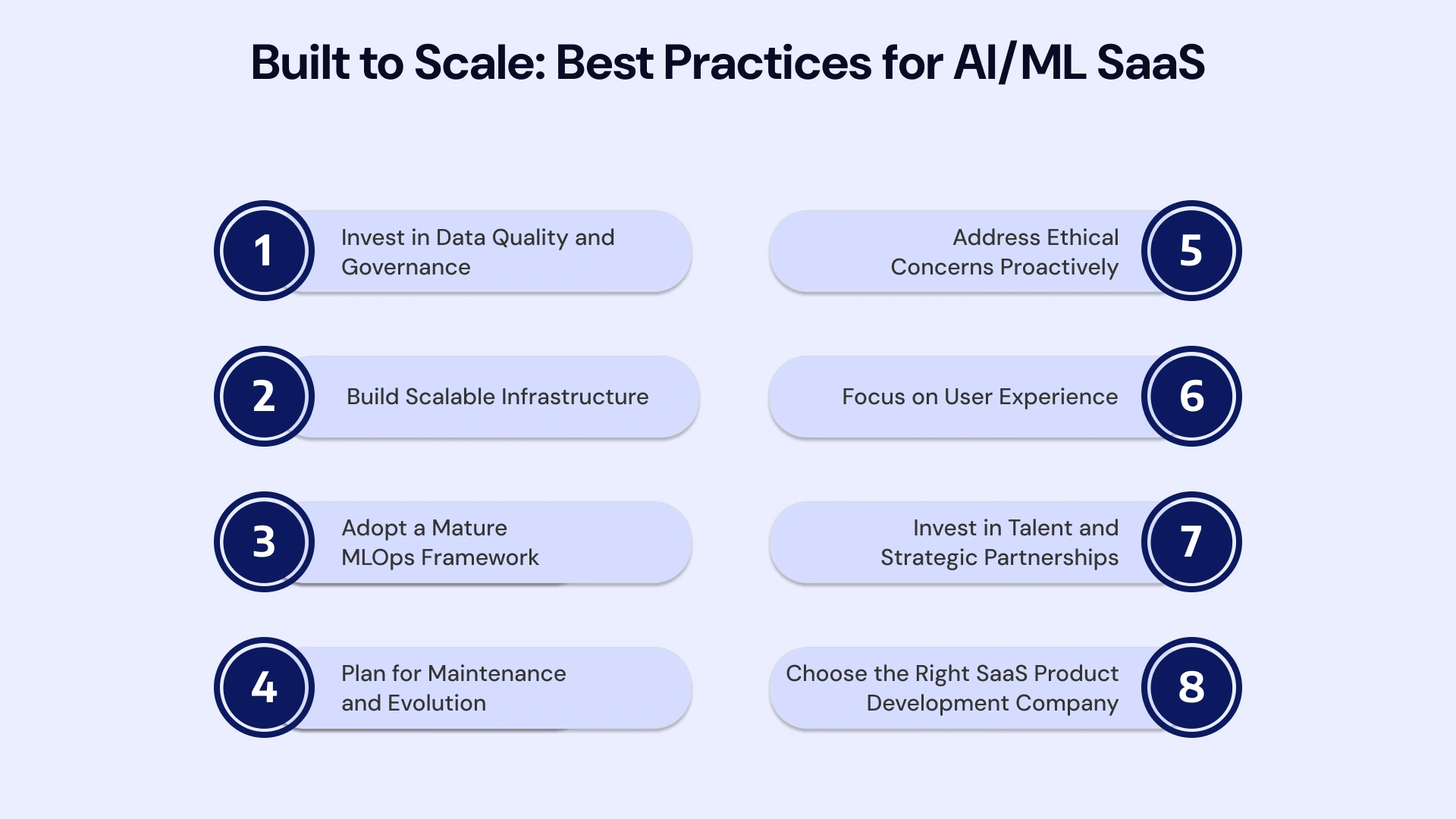
Here are some of the key solutions to AI/ML pitfalls:
Invest in Data Quality and Governance:
Data is the fuel for your AI. Without high-quality, well-governed data, your models will fail to perform effectively. Implement robust data validation pipelines to detect and automatically correct inconsistencies and errors. Establish a clear data governance framework that defines ownership, access controls, and compliance rules to ensure effective management of data. This ensures that the data your models consume is not only accurate but also secure and ethically sourced.
Build Scalable Infrastructure:
The computational demands of AI/ML are immense. A static infrastructure is a recipe for failure. Leverage multi-cloud strategies to avoid vendor lock-in and ensure redundancy. Utilize elastic computing services that can automatically scale resources (CPU, GPU) up or down based on real-time demand. This ensures optimal performance during peak usage while keeping costs manageable, a key aspect of effective cost management of AI/ML SaaS.
Adopt a Mature MLOps Framework:
A successful AI product requires a continuous cycle of development, deployment, and monitoring. This is where MLOps comes in. Implement monitoring tools that track model performance, data drift, and other key metrics to ensure optimal performance. Automate retraining pipelines that trigger when a model's performance degrades. This ensures your AI remains accurate and relevant over time, demonstrating a high level of MLOps maturity in ML SaaS.
Plan for Maintenance and Evolution:
AI models are not "set it and forget it" systems. They require continuous maintenance. Allocate long-term resources for model retraining, compliance updates, and feature enhancements. Proactive planning helps you avoid technical debt and ensures your platform remains competitive and compliant with evolving regulations.
Address Ethical Concerns Proactively:
Bias and fairness are not just ethical considerations; they are business risks. Build bias detection frameworks into your development pipeline to identify and mitigate unfairness in your models. Address Ethical Concerns by diversifying your training data and ensuring transparency in how your AI makes decisions.
Focus on User Experience:
A powerful AI model is useless if users can't interact with it effectively. Focus on User Experience by designing intuitive and transparent interfaces. Provide explainable AI insights so users can understand why a model made a particular prediction, which builds trust and reduces customer churn challenges in AI SaaS scaling.
Invest in Talent and Strategic Partnerships:
The global shortage of AI talent is a significant challenge in resource allocation for scaling AI/ML. Invest in Talent by hiring skilled engineers and data scientists. Additionally, consider partnering with a specialized AI Development Company or ML Development Company to gain access to a broad range of expertise on demand.
Choose the Right SaaS Product Development Company:
Not all development partners are created equal. When selecting a company for your saas development services, ensure they have a proven track record in AI/ML. Look for a partner with expertise across cloud architecture, MLOps, and a deep understanding of your industry's unique challenges.
Successfully navigating the pitfalls of scaling AI SaaS and ML SaaS requires a strategic mindset that prioritizes long-term value over short-term gains. It's a continuous process of evolution and adaptation, not a one-time deployment. The key is to build scalable infrastructure, a maintenance plan, and invest in talent from the start. For enterprises and startups alike, managing the cost management of AI/ML SaaS is a critical factor.
By optimizing resource allocation and adopting a lean approach to model development and deployment, companies can maximize their ROI. Similarly, understanding the business risks of poor AI SaaS scaling and LSI keywords can help in creating a more resilient business model.
Use Cases of Scaling AI/ML SaaS
The demand for scaling AI/ML SaaS is driven by real-world applications that demonstrate tangible business value. Here are some use cases of scaling AI/ML Saas across different industries:
- Fraud Detection SaaS: In the financial technology sector, AI models are trained on massive datasets of transactions. When an AI/ML SaaS scales, it can analyze millions of transactions in real-time, continuously learning new patterns of fraudulent activity. This allows it to detect anomalies and block suspicious transactions instantly, a task that would be impossible for a human team to accomplish.
- Healthcare SaaS: In healthcare, ML-driven diagnostics improve with expanding patient datasets. As more anonymized patient data is fed into a model, its ability to identify diseases from medical images (e.g., X-rays, MRIs) or patient records becomes more accurate. This offers personalized medical insights, enabling clinicians to make more informed decisions at a population level.
- HR SaaS: Predictive analytics in HR scales workforce management decisions for large corporations. By analyzing employee data, an AI-powered HR platform can predict employee churn, identify skill gaps, and optimize talent acquisition strategies. This enables companies to make data-driven decisions on a global scale, from small teams to multinational enterprises.
- Customer Engagement SaaS: NLP-based chatbots and virtual assistants scale personalization at a large scale. An AI/ML SaaS platform can handle millions of customer queries simultaneously, providing instant and accurate responses. Over time, these systems learn from customer interactions to provide more nuanced and helpful responses, improving customer satisfaction and support efficiency.
- E-commerce SaaS: Recommendation systems evolve as catalogs grow. As an e-commerce platform adds more products and gains more user data, its recommendation engine, powered by ML, becomes more sophisticated. It can offer personalized product suggestions to millions of users, leading to increased sales and customer loyalty.
- Cybersecurity SaaS: AI-powered cybersecurity platforms scale to monitor billions of network events in real-time. They use ML to detect and flag potential threats, such as malware, phishing attempts, or unauthorized access, with a high degree of accuracy and speed that is far beyond human capability.
Building Success with VLink: How Our AI/ML Services Help You Win
Successfully navigating the complex landscape of scaling AI/ML SaaS requires a partner who understands both the intricacies of the technology and the business challenges it presents. This is where VLink comes in.
As a leading provider of AI/ML development services, we offer a comprehensive suite of solutions designed to help you overcome AI/ML SaaS pitfalls and achieve your business goals. Our SaaS development services are tailored to your specific needs, whether you are a startup looking to build a proof-of-concept or an enterprise aiming to modernize a legacy system with cutting-edge AI.
Here's how we help you avoid the common pitfalls of scaling AI/ML SaaS:
- Data-Centric Approach: We help you invest in data quality by building robust data pipelines and implementing governance frameworks to ensure your data is clean, compliant, and ready for model training and deployment.
- Scalable Infrastructure: Our dedicated team builds scalable infrastructure on AWS, Azure, and GCP, leveraging microservices and serverless architectures to ensure your platform can handle exponential growth without performance degradation.
- MLOps and Maintenance: We implement a mature MLOps pipeline that includes automated monitoring, retraining, and continuous deployment, ensuring your models stay relevant and accurate over time.
- Strategic Talent: We offer IT staff augmentation and dedicated team models to help you invest in talent and fill critical skill gaps, providing access to a global pool of AI and ML experts.
By partnering with VLink, you are not just getting a vendor; you are gaining a strategic partner dedicated to your success. We have helped numerous companies across various sectors, from fintech to healthcare, leverage the power of AI and ML to drive growth and innovation.
Conclusion
The journey of scaling AI/ML SaaS is fraught with challenges, from the technical complexities of MLOps maturity in ML SaaS to the business risks of poor resource allocation in AI/ML scaling. However, by recognizing and preparing for these pitfalls of scaling AI/ML SaaS, companies can build resilient and future-ready platforms that deliver immense value to their customers.
Successfully scaling AI/ML requires a holistic approach that prioritizes data quality, robust infrastructure, and a deep understanding of customer needs. Whether you are building from scratch or looking to enhance an existing product, the key is to be proactive and partner with experts who can help you navigate the complexities of AI development.
Let’s build the future of SaaS together. Contact us today to discuss your AI/ML SaaS scaling challenges with our experts.
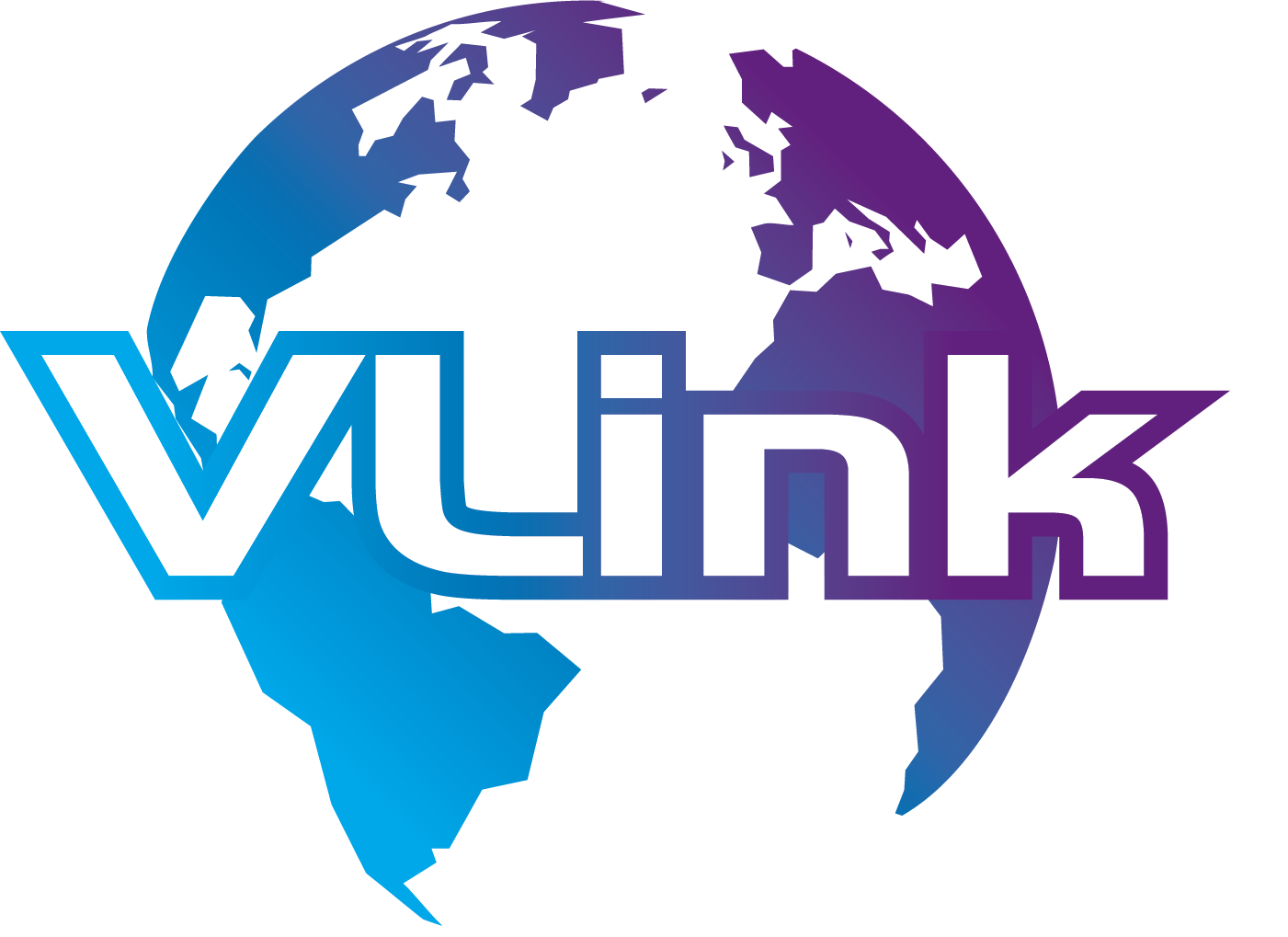




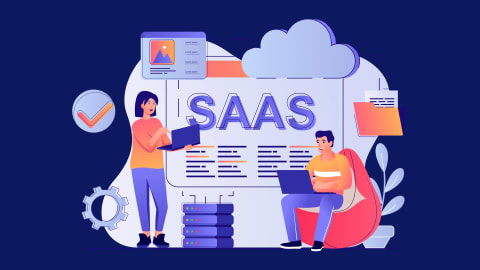




 Shivisha Patel
Shivisha Patel

















